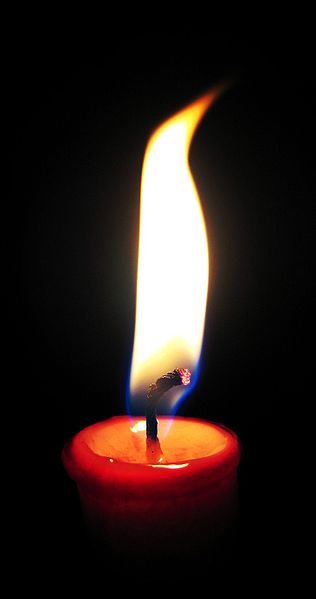According to tradition, the duty of lighting the second candle of the Advent wreath falls to the oldest child. While the youngest child likely leaped at the chance last Sunday, you may have to nudge a curmudgeonly teen towards the task today.
Still, tradition is tradition (and no, the job cannot be delegated). Take hope, though: few people, be they tykes or octogenarians, ultimately can resist the fascination of a candle’s flame.
 Lit candles are amazing things. Since the first nameless person figured out how to soak a fibre in something to both aid and slow its burning, candles have fascinated humans. Their flames not only hold our gaze but change our sense of pace. When two or more persons gather socially around a candle, time can stop. A specific feeling arises, one that the Germans nicely have named Gemütlichkeit— a gentle, meaningful emotional connection inadequately rendered in English as “coziness.”
Lit candles are amazing things. Since the first nameless person figured out how to soak a fibre in something to both aid and slow its burning, candles have fascinated humans. Their flames not only hold our gaze but change our sense of pace. When two or more persons gather socially around a candle, time can stop. A specific feeling arises, one that the Germans nicely have named Gemütlichkeit— a gentle, meaningful emotional connection inadequately rendered in English as “coziness.”
The act of lighting a candle has a magnificence built into it. Yes, it is a simple gesture. A hand extends with a flame towards a waiting wick. But that gesture has the power to accomplish something miraculous: to transform darkness into light.
The traditional use of candles in liturgical Christian worship proclaim significant parts of the Christian message, particularly in the reading of the Gospel and the Eucharist. Powerful, too, is the role candles play in Judaism, including the Friday-evening observances of Shabbat (Sabbath).
We can find at least sixteen mentions of candles across the Old and the New Testaments (although arguably some or all refer to lanterns—we’ll let the scholars work that out). The first appears in Job 18:6:
The light shall be dark in his tabernacle, and his candle shall be put out with him.
And the final one in Revelations 22:5:
And there shall be no night there; and they need no candle, neither light of the sun; for the Lord God giveth them light: and they shall reign for ever and ever.
Aside from all of this, my favorite experience with candles in worship might be yours too: the timeless gesture of that single flame lit at the first notes of Silent Night in a darkened church on Christmas Eve. Slowly it spreads, candle to candle, across the nave until each face is illuminated by a candle’s flame. No matter how many decades I served as an organist, playing as many as five Christmas Eve services, I never failed to be astonished and moved to tears.
Still, in case none of this impresses your reluctant teen, the next stop could be to consider the science of combustion that takes place every time a flame hits a wick. Computer specialist Graham Kirby, who writes a science blog for young people, describes the process clearly:
When you light the wick on a candle, the heat melts the wax in the wick and at the top of the candle. This liquid wax is drawn up the wick by capillary action, getting hotter and hotter until it turns into a gas. This gas mixes with oxygen in the air and is ignited by the flame that melted the wax in the first place. The heat of the flame melts more wax and this wax too is drawn up the wick.
This process continues until there is no more wax or wick. Simple enough, and yet is it not always miraculous?
Finally, if chemistry fails, the final arrow in my quiver would be the reason we do such things in the first place. We imbue candles of the Advent Wreath with specific meaning so as to partake in the discipline of tradition. Whether you take a light touch to celebrating Advent (the wreath or an Advent calendar), an intense one (penitential fasting leading to the holiness of Christmas Eve), or fall somewhere in the middle, the details of the traditions we receive about Advent belong to a larger spiritual discipline. We may not understand it all, or even believe it all. But that discipline exists and continues to exert its efficacy from ancient times down to our own. It reminds me of the words we hear a thousand times growing up (and likely repeat to our children): “Why?” “Because it’s good for you.”
So, oldest children, consider it any way you wish, but enjoy, even cherish, the peace and connectivity that lighting this candle brings. You are reaching into the distant past, with eyes fixed on the present. One day in the future, God willing, you will be the person who undoes the cellophane wrapping of four Advent candles and positions a wreath before the excited eyes of your own children. And you will be ready.



